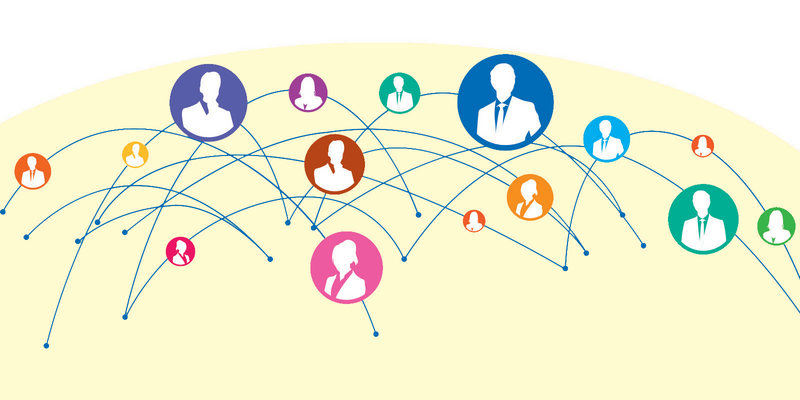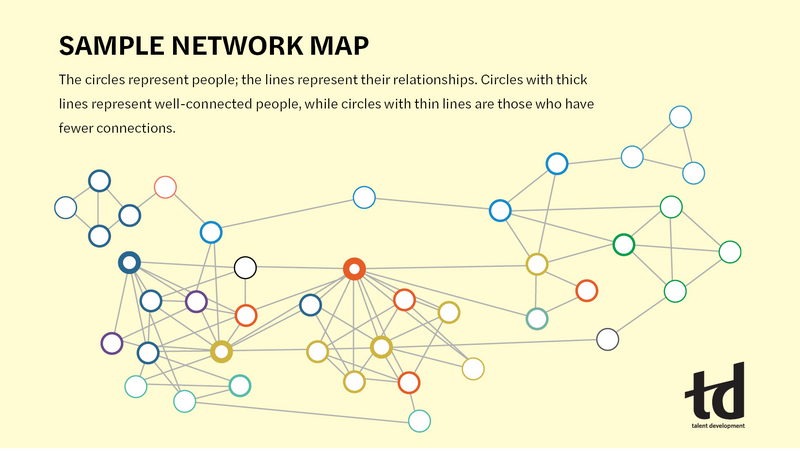TD Magazine Article
Uncover Hidden Potential With Network Analytics
Mapping relationships can help organizations build capacity, span silos, and accelerate change.
Mon Mar 02 2020

"Coming together is a beginning. Keeping together is progress. Working together is success." That iconic quote from the late industrialist Henry Ford, founder of Ford Motor Company, rings as true now as during his lifetime. Whether employees sit on the executive team or work on the front lines, relationships within and beyond a company are vital to workplace success.
Today's technology-connected workplaces are transforming how relationships form by making it faster and easier to share information and influence opinions. Even remote employees who don't talk around the proverbial water cooler aren't isolated. Chat tools, videoconferencing, and a host of other apps make it possible to interact, exchange ideas, propose solutions, and build networks across oceans, departments, and organizations.
The result is a complex web of relationships that affects organizations. Employers can use these internal networks to propel their business forward—if they take the time to map them, analyze what they find, and match them to the organizational strategy. In fact, companies can uncover answers to a broad range of questions that influence key outcomes for individual employees, teams, and the organization as a whole.
Consider these questions: Are your company's current (and future) leaders cultivating the relationships they need to thrive in a workplace reliant on teamwork? Are the right departments working together to meet the organization's needs? Are key leaders aligned in support of core strategies and change initiatives?
If any of those questions are relevant to your organization, network analytics can be a strategic tool in the talent development function's arsenal. Network analytics can help you uncover previously hidden employee connections and use them to advance outcomes you care about, such as inclusion, efficiency, collaboration, strategic development, and retention. In addition, a network analysis helps companies visualize connections between employees, teams, and departments—providing the information leaders need to make informed decisions that maximize results.
At the individual level, you can see whether employees interact with co-workers equally or whether there are key opinion leaders. At the group level, you can determine whether departments collaborate frequently or operate in silos. You can even examine how well connected your organization is to the local community or global marketplace. Once you understand these previously invisible connections, you can determine how to work with, rather than against, the existing flow of information and influence.
The insights you uncover can help the broader organization address its most pressing business challenges. Companies across the world have used network analytics to improve efficiency, decrease onboarding time, boost innovation, minimize turnover, drive strategy, prepare for disruptive changes, and ensure important voices are represented in strategic decisions. Employers can stop wasting time, energy, and resources on strategies that simply won't work by becoming more informed about how their workplace is connected.
There are three steps to using network analytics effectively: Gather network data, map and analyze the connections, and leverage network analytics to plan strategy.
Gather network data
Your starting point is to gather data about who interacts with whom so you can map relationships across the organization. Many companies take a direct approach and survey employees about whom they interact with, how often, and for what purpose. You could include questions that explore the quality or scope of those relationships, such as whom employees seek out for support, innovative ideas, or career advice. Mapping connections that are most relevant for the organization's challenges will provide the insights your company needs to support change.
Indirect data collected without surveys also can prove valuable. For example, map calendar invites, project membership, frequency of email exchanges, and related interaction data to identify connections.
For either approach, consider collecting employee information, such as job title and department, to better understand who is represented in your company's network. Finally, consolidate the gathered information into a single spreadsheet, with a row of data for each employee.
One important decision point during this data-collection phase is whether the collected information will be confidential or personally identifiable. Rather than identifying specific employees, link their responses to their length of tenure or, if relevant, office location and gender. Collecting confidential information can contribute to greater psychological safety because employees are not individually identified in the network maps. Other questions, such as identifying key opinion leaders, require identified data. Be fully transparent with employees about whether you will use personally identifiable data, how you will use it, and why you made that decision.
Map and analyze the connections
Next, use the collected information to create maps representing the relationships you've uncovered. Quantitative data experts can be a big help here, because they use sophisticated statistical methods to identify patterns of connectivity among individuals and across functions, divisions, and hierarchies. Your objective is to create an easy-to-follow, visual representation of workplace relationships.
What does a network map look like? In the figure on page 54, circles represent people and lines represent their relationships. The thinner circles show employees with fewer interactions at work. The thicker circles show the most connected individuals—those who serve as information brokers or opinion leaders. They may be in a position to span boundaries and work with various groups across the organization. You can label circles based on characteristics of individuals—for example, the colors in the figure may represent which department an individual belongs to.
Once you have your network maps in hand, explore them for insights. The way you make sense of the findings depends on whether you decided to identify individuals. If you gathered personally identifiable information, you'll see who the key players or teams are and how they interact to form cross-boundary connections and centers of influence. For instance, the thicker orange circle in the sample network map may be considered a key influencer.
If you decided against gathering personally identifiable information, focus on overarching patterns of connectivity and how work happens across employees, teams, and functional boundaries. For example, the sample network map may suggest that the yellow and orange teams collaborate with one another, while the green and light blue teams are more siloed.
Take the time to solicit key stakeholders' and top management teams' reactions to your network maps. Ask whether anything stands out and whether they are surprised by the connection patterns. Think through how your findings relate to the employee, team, and organizational outcomes that are most important for your company.
Leverage network analytics to plan strategy
You can use what you learn from the networks in many ways. For example, you can target training and development efforts to promote collaboration and teamwork where it is needed most. Or you can elevate your role by sharing what you learn with executives and functional leaders across the organization; together you can uncover bottlenecks and encourage purposeful connections that may be missing.
The uses of network analytics that have the most impact include fostering reflection and facilitating change. Many change initiatives underperform because those leading the charge fail to consider the ways people naturally work and collaborate. However, when organizations take the time to understand the unique patterns of interaction and workflow, they can accelerate change initiatives and help them succeed.
During the planning stage for a new change initiative, network analytics can inform strategic decisions about program design. If, for instance, an organization discovers that there is frequent communication among departments, it will likely be easy to align everyone behind important initiatives. Leaders may recommend an organization-wide launch of a change initiative rather than a phased rollout. If instead there are high-influence departments or opinion leaders who tie together otherwise disconnected groups, it may be wise for organization leaders to partner with those influencers to introduce new ideas or to gain insights into how receptive or resistant employees will be.
During the implementation stage, information about employee connections can also help an organization roll out new strategies, innovation efforts, or other changes in a more targeted fashion. Executives launching a new quality process, for example, can look for employees with close connections within and beyond their departments who can become early adopters (assuming personally identifiable information was collected). To improve a product development pipeline or grow market share, the appropriate functional teams can assess whether the right groups are interacting to promote innovation and boost sales.
Organizations can even use network analytics to explore why silos may exist. For example, are disconnected teams located in different physical locations? If so, leaders could promote collaboration by facilitating travel between sites or by hiring new team members to work together on location. With insights from network analytics, companies can make real change happen more quickly and more naturally.
Network analytics in action
How do network analytics work in the real world? A new dean at a top nursing school, partnering with the Center for Creative Leadership, used network analytics to better understand the team she was leading and plan a strategic reorganization to boost collaboration. Network maps indicated low levels of connectivity among community members, suggesting that they functioned more like an unconnected team of independent contractors than a cohesive group. The dean found little interaction, even by program, function, or role.
The network analysis brought legitimacy to restructuring efforts by readily illustrating the need for improved connectivity. It also helped the dean identify informal, highly trusted leaders from across the school who were a good fit for a steering committee that would plan the reorganization. Committee members were able to design and accomplish a successful restructuring within a tight timeframe and with broad faculty and staff support. The school accomplished a top-to-bottom restructuring in a short time and with broad support by strategically identifying thought leaders.
In another example, a pharmaceutical company partnered with the Center for Creative Leadership to spur innovation by increasing organizational cross-talk. Network analytics revealed that 38 percent of employees didn't know each other, and 87 percent of daily communication was between employees housed on the same floor. As a result, the company reorganized office space to promote cross-team collaboration. It also engaged in boundary-spanning coaching to encourage employees to make connections outside their teams.
In both examples, network analysis pointed toward concrete actions to make strategic changes for the better. Whatever a company's goal, network analysis can provide a lens that enables talent development leaders to leverage their organizations' social engines and identify promising starting points for improving individual, team, and organizational outcomes.
Rewiring Connections
If a network analysis suggests current connections are impeding day-to-day workflow, an organization can rewire connections to encourage new patterns of work and social activity. Here are three broad approaches talent development leaders should keep in mind.
Restructure the environment. Proximity and the physical design of workplaces can affect interaction patterns. Consider co-location of teams that need to work closely together. Alter the placement of break rooms and other informal meeting spaces to promote interaction and encourage greater collaboration, innovation, and productivity.
If teams are geographically dispersed, look for ways to promote collaboration across functions and organizational barriers. Set up small working groups that partner remotely to solve an internal business challenge. Consider short-term job swaps or work assignments that will take employees to a new location where they can build new connections.
Redesign the organizational structure and processes. The way employers organize teams and the way in which companies establish internal processes can have a significant influence on workplace relationships. If either is too rigid, an organization can stifle creativity, create bottlenecks, and reinforce silos. Take a critical look at your company's business model, strategy, structure, organizational chart, and the processes that govern how employees accomplish work. Can you make changes to shift collaboration patterns and help bring important strategies to life?
Build a strategic change network. Innovation is vital to any organization's success. If your network map shows your company lacks effective connections to support innovation or share new ideas, it may be time to redesign workplaces to foster and encourage fresh ways of thinking.
To get started, engage a team of change agents who can unite individuals from across the organization to spur collective action and bring strategy to life. If you collected personally identifiable information to build relationship maps, network analytics can help you readily identify great candidates. If you didn't collect personal information, look to well-connected teams and ask for nominations or volunteers. Make sure to include members from across the company to encourage boundary spanning. Senior leaders also can use connections from their personal networks to identify employees who are well positioned, willing, and able to help intentionally bridge communication gaps and barriers.
Sample Network Map

The circles represent people; the lines represent their relationships. Circles with thick lines represent well-connected people, while circles with thin lines are those who have fewer connections.
The Expanding Role of Analytics
There is no doubt that the age of big data analytics has arrived. It is changing what talent development professionals know, how quickly they know it, and what they do with what they learn.
Businesses worldwide have used analytics to transform their operations by uncovering insights buried in mountains of data and making them actionable. Now, this same data-based approach is making its way into the HR side of the equation.
What can a talent development team do with analytics? It can understand and leverage networks in ways that can boost employee, team, and organizational performance; identify the attributes of effective leaders and predict the best hires; and understand how to retain employees, improve equity and diversity, drive collaboration, create successful teams, and improve learning.
Ultimately, analytics can help the talent development function get a clear and actionable picture of how work is getting done and how leader behaviors and practices, networks, culture, and employee experience and engagement influence the company's most important business strategies.
Your objective is to create an easy-to-follow, visual representation of workplace relationships.
When organizations take the time to understand the unique patterns of interaction and workflow, they can accelerate change initiatives.

